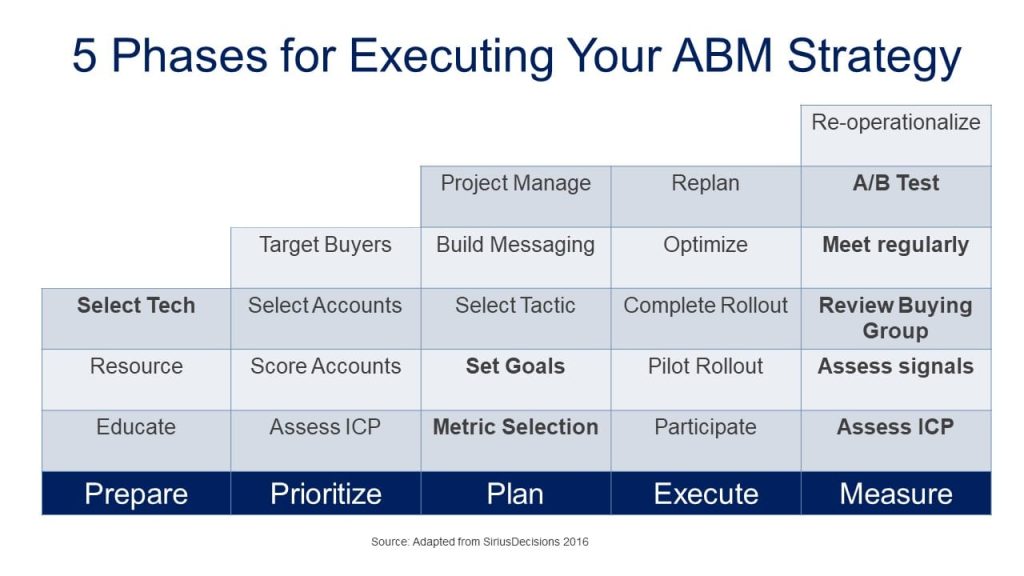Account-based marketing is the future of B2B marketing. In fact, ABM is so powerful for most businesses that it’s highly likely it will be the dominant strategy for most B2B marketing teams. Many companies have started ABM experiments and their marketing teams are left wondering the best way to roll out an effective ABM strategy: incrementally or all at once.
The Case for Phasing in Your ABM Strategy
First things first, an incremental approach works best. As ABM was gaining widespread popularity for the first time in 2016, the SiriusDecisions (now Forrester) blog published a post warning marketers about a common mistake teams were making when adopting ABM – selecting accounts as the first step. For reference, the post included the SiriusDecisions Account-Based Marketing Framework.
Even though the Forrester post was published a few years back, the fundamentals remain true. Their positioning emphasized the preliminary steps that should take place prior to selecting accounts, which is useful advice. But let’s adapt the framework for broader use and talk about how marketing teams can use the five phases it identifies to set up an ABM strategy. Here’s a graphic adapted for that purpose:

- Prepare: The first step is to prepare your efforts for success by educating colleagues about ABM and getting buy-in for taking the marketing program in a new direction. This step is crucial even though the expected resistance will be low due to ABM’s popularity and its demonstrated effectiveness and efficiency. Better yet? Technology has solved the scaling problem that previously held B2B marketers back. However, adopting ABM does involve process changes that require the resources, technology, and knowledge to chart this path. Therefore, it is essential not to skip this step.
- Prioritize: Setting priorities comes next, and job #1 is to focus on the Ideal Customer Profile (ICP), which may have changed over the past few years. If the ICP needs to be revisited, this is a great time to do so and then apply the redefined or reconfirmed ICP to accounts. Stack rank companies according to fit, then use the rankings to select your target accounts.
The next priority is to identify the buyers in target accounts, and ICPs come into play here as well but for individuals rather than companies. Are you selling to CFOs? CMOs and/or VPs of Marketing Ops? Buying groups can be large in the B2B world, so you’ll need to know which roles to target and, finally, whom to reach out to using data from Zoom Info or a similar business data provider. You can mark target accounts in the CRM and add individuals as contacts.
- Plan: The first step in the planning phase is to select the metrics you’ll use to measure success. For example: out of 1,000 identified accounts, your goal is to sell to 100 of them. Or maybe you’ve set an objective to activate 300 of the 1,000, which would entail campaigns to entice the people you’ve identified to engage with your website content, attend an event, download a whitepaper or take some other action. In the planning phase, you set the goal and select tactics (such as email, ad campaigns, etc.), create messaging, and manage outreach projects.
- Execute: At the outset of the execution phase, it’s important to identify participants to help support the program, e.g., the customer support team if it’s an upsell campaign. Once you have the right support, you can roll out the pilot. It can be a single pilot program or a series of them, but the point is, don’t stop the programs you already have in place; the pilot tests how effectively the program targets accounts, how successful the messaging is, etc. The full rollout should follow success in the pilot program, with optimization and replanning part of the process.
- Measurement: Next up is the measurement, which is critical. You’ll want to assess whether your ICP is correct and evaluate signals, i.e., how people are engaging with your campaigns and what the results are in terms of closed/won deals and activations. You’ll need to review the buying group and make sure you’ve identified the right people. Measurement tools like Full Circle’s ABM Funnel Metrics and Attribution will be crucial for these tasks. This phase should also include regular meetings for the project team to discuss results, identify opportunities and look for and mitigate errors. It should also include A/B testing for messaging and campaign types to re-operationalize the ABM strategy.
So, marketers who launch or relaunch an ABM strategy tend to get the best results with an intentional, phased rollout as described here. There’s significant preliminary work, but a step-by-step approach pays off by ensuring full buy-in prior to rollout, building in success metrics and testing activities, and using measurement tools to refine tactics and continuously improve results.
Once the ABM strategy is fully rolled out, it becomes cyclical, and the measurement phase can help you keep the virtuous cycle going. That’s the best way to optimize your ABM launch and continue to take advantage of ABM’s efficiency into the future.



